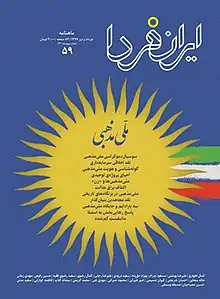Iran-e-Farda
Iran-e Farda (Persian: ایران فردا, romanized: Īrān-i fardā, lit. 'Tomorrow's Iran') is an Iranian nationalist-religious periodical publication printed in magazine-format and published digitally that focuses on current sociopolitical affairs of Iran.
 | |
 Cover of No. 131, June 2020 | |
| Editor | Keyvan Samimi |
|---|---|
| Categories | Social, Political, Economical, Cultural |
| Frequency |
|
| Format | A4 |
| Publisher | Hamed Sahabi |
| Total circulation (2000) | 50,000 |
| Founder | Ezatollah Sahabi |
| Founded | 1992 |
| First issue | June 1992 |
| Final issue | December 2020 |
| Country | Iran |
| Based in | Tehran |
| Language | Persian |
| OCLC | 1011738022 |
History
Iran-e-Farda began publication in 1992.[1] As of December 1995, one survey found that the magazine was Iran's leading political monthly.[2] In 1996, the state-run IRIB TV1 aired a programme named Hoviyat which frequently attacked Iran-e-Farda and accused it of being one of the "bases for the West's cultural invasion of Iran".[3] In response, the magazine's managing director Ezatollah Sahabi wrote an open letter to President Akbar Hashemi Rafsanjani, which was published by Salam, asking for an opportunity to defend itself.[3] During presidency of Mohammad Khatami, it became increasingly outspoken in advocating civil society and asked Khatami to fulfill his promises and called for more freedom and tolerance.[4] It also frequently criticized the conservative establishment.[5]
The magazine was banned in April 2000[6] during crackdown of more than a dozen reformist newspapers.[7] At the time, it had been published on a biweekly basis and had an estimated circulation of 50,000 which was several times more than most other periodicals in Iran.[8]
Iran-e-Farda was relaunched in May 2014 but ceased publication in December 2020, after it was banned again.[9]
Political alignment
The magazine was known as the mouthpiece of the Council of Nationalist-Religious Activists of Iran[10] and has been described as "an intellectual monthly which became a forum for their liberal notion of Islam",[11] as well as "associated with the Freedom Movement of Iran".[12] According to Wilfried Buchta, the magazine was where "Islamic-left" and "nationalist-religious" were gathered around Ezatollah Sahabi.[13] Yadullah Shahibzadeh argues that post-Islamist and neo-Shariatist movements have been associated with Iran-e-Farda and used it as a platform to enter the public space in the 1990s.[1]
Staff
Ezatollah Sahabi was the founder and managing director of Iran-e-Farda and Reza Alijani was its editor-in-chief.[14] After relaunch in 2014, Kayvan Samimi served as its editor-in-chief and Hamed Sahabi was the magazine's publisher.[9]
Contributing editors and other columnists who at some time have wrote for Iran-e-Farda include:
References
- Shahibzadeh, Yadullah (2016). Islamism and Post-Islamism in Iran: An Intellectual History. Springer. pp. 102–103. ISBN 9781137578259.
- Cronin, Stephanie (2013). Reformers and Revolutionaries in Modern Iran: New Perspectives on the Iranian Left. Routledge/BIPS Persian Studies Series. Routledge. p. 62. ISBN 1134328907.
- Mobasser, Nilou (1996), "Identity parade", Index on Censorship, 25 (6): 174, doi:10.1080/03064229608536164
- Kamrava, Mehran (2001), "The Civil Society Discourse in Iran", Index on Censorship, 28 (2): 170, JSTOR 826123
- Jehl, Douglas (15 October 1998), "Issue in Iran Democracy Debate: Clerics' Power", The New York Times, retrieved 5 March 2021
- Parray, Tauseef Ahmad (2013), "Iranian Intellectuals on "Islam and Democracy"Compatibility: Views of Abdulkarim Soroush and Hasan Yousuf Eshkevari", Journal of Middle Eastern and Islamic Studies (in Asia), 7 (3): 43–64, doi:10.1080/19370679.2013.12023227
- Dareini, Ali Akbar (30 April 2000), "Pro-Khatami Activist Jailed in Iran", Associated Press, retrieved 5 March 2021
- Shahidi, Hossein (2007). Journalism in Iran: From Mission to Profession. Routledge; Reissue edition. pp. 78, 125. ISBN 978-0415583169.
- "Iranian journalist Kayvan Samimi begins 3-year prison sentence over protest coverage", Committee to Protect Journalists, 8 December 2020, retrieved 5 March 2021
- Sahimi, Muhammad; Geist, Dan (7 April 2011), "Jailed Iranian Journalist Ahmad Zeidabadi Wins World Press Freedom Prize", Tehran Bureau, PBS, retrieved 5 March 2021
- Mir-Hosseini, Ziba (2002), "The Conservative: Reformist Conflict over Women's Rights in Iran", International Journal of Politics, Culture, and Society, 16 (1): 37–53, JSTOR 20020147
- "The Iranian press", Index on Censorship, 27 (4): 141, 1998, doi:10.1080/03064229808536401
- Buchta, Wilfried (2000), Who rules Iran?: the structure of power in the Islamic Republic, Washington DC: The Washington Institute for Near East Policy, The Konrad Adenauer Stiftung, p. 83, ISBN 0-944029-39-6
- "2 Iranian Dissidents Seized", The Associated Press, The New York Times, 18 December 2000, retrieved 5 March 2021
- Sahimi, Muhammad (13 June 2011), "Reza Hoda Saber, Political Prisoner, Dies after 9-Day Hunger Strike", Tehran Bureau, PBS, retrieved 5 March 2021
- "Iran", Index on Censorship, 29 (5): 88, 2000, doi:10.1080/03064220008536808
- "Iran", Index on Censorship, 32 (3): 149, 2003, doi:10.1080/03064220308537268
External links
- Iran-e-Farda at iran-archive.com